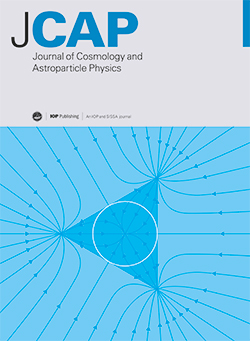Power spectra in double-field inflation using renormalization-group techniques
IF 5.9
2区 物理与天体物理
Q1 ASTRONOMY & ASTROPHYSICS
Journal of Cosmology and Astroparticle Physics
Pub Date : 2025-07-09
DOI:10.1088/1475-7516/2025/07/030
引用次数: 0
Abstract
A perturbative strategy for inflation described by two-inflaton fields is developed using a mathematical analogy with the renormalization-group. Two small quantities, α and λ, corresponding to standard slow-roll parameters are defined and systematic expansions of all inflationary quantities in terms of powers of α and λ are found. No other slow-roll parameters are needed. To illustrate this perturbative method in the multi-field context, we adopt a simple two-inflaton model with quadratic potentials in the parameter range where both fields contribute similarly to the dynamics of inflation. The model, even though it is not a viable alternative for phenomenological description of the inflationary period, nicely illustrates subtleties of the perturbative approach. In particular, this method allows us to derive two independent gauge-invariant scalar perturbations that are conserved in the superhorizon limit, overcoming typical problems that emerge in multi-field inflation. Furthermore, it is possible to perform nonperturbative resummations that allow to study the model in a true multi-field regime. We derive tensor and scalar power spectra to the next-to-next-to-leading and next-to-leading orders, respectively, as well as their spectral indices. The hierarchy between the two scalar perturbations allows us to single out the dominant entry of the scalar power-spectrum matrix. Modifications due to the second inflaton occur already at the leading order. Finally, we explain why the quadratic two-inflaton model is not compatible with the present experimental constraints even though non-trivial corrections to scalar perturbations do emerge.利用重整化群技术研究双场膨胀中的功率谱
利用与重整化群的数学类比,提出了由两个暴胀场描述的暴胀扰动策略。定义了与标准慢滚参数相对应的两个小量α和λ,并找到了所有暴胀量以α和λ的幂表示的系统展开式。不需要其他慢滚参数。为了在多场环境下说明这种微扰方法,我们采用了一个简单的双膨胀模型,在参数范围内具有二次势,其中两个场对膨胀动力学的贡献相似。这个模型,尽管不是对暴胀期的现象学描述的可行替代方案,却很好地说明了微扰方法的微妙之处。特别是,这种方法使我们能够推导出两个独立的在超视界极限下守恒的规范不变标量微扰,克服了多场暴胀中出现的典型问题。此外,可以执行非摄动恢复,以便在真正的多场状态下研究模型。我们分别导出了张量和标量功率谱的次-次-前阶和次-前阶,以及它们的谱指数。两个标量扰动之间的层次结构使我们能够挑出标量功率谱矩阵的主导项。由第二次膨胀引起的修正已经发生在第一阶。最后,我们解释了为什么二次双膨胀模型与目前的实验约束不兼容,即使对标量扰动的非平凡修正确实出现了。
本文章由计算机程序翻译,如有差异,请以英文原文为准。
求助全文
约1分钟内获得全文
求助全文
来源期刊

Journal of Cosmology and Astroparticle Physics
地学天文-天文与天体物理
CiteScore
10.20
自引率
23.40%
发文量
632
审稿时长
1 months
期刊介绍:
Journal of Cosmology and Astroparticle Physics (JCAP) encompasses theoretical, observational and experimental areas as well as computation and simulation. The journal covers the latest developments in the theory of all fundamental interactions and their cosmological implications (e.g. M-theory and cosmology, brane cosmology). JCAP''s coverage also includes topics such as formation, dynamics and clustering of galaxies, pre-galactic star formation, x-ray astronomy, radio astronomy, gravitational lensing, active galactic nuclei, intergalactic and interstellar matter.
 求助内容:
求助内容: 应助结果提醒方式:
应助结果提醒方式:


